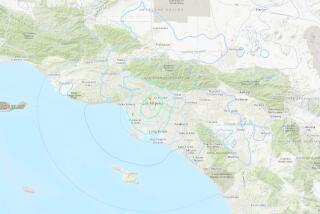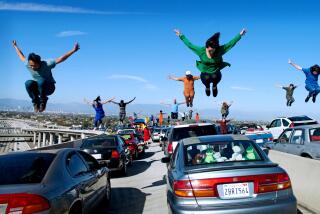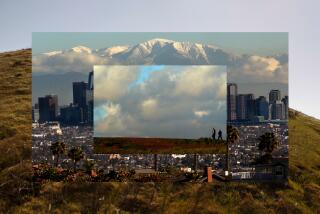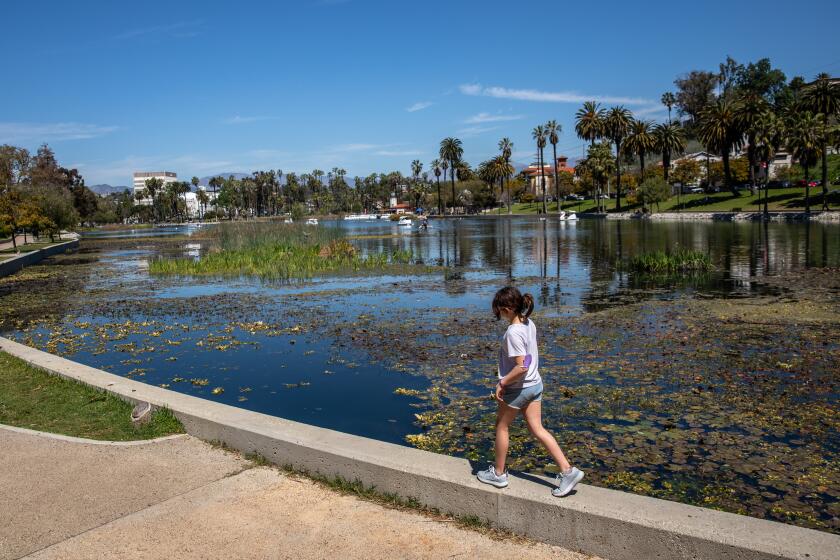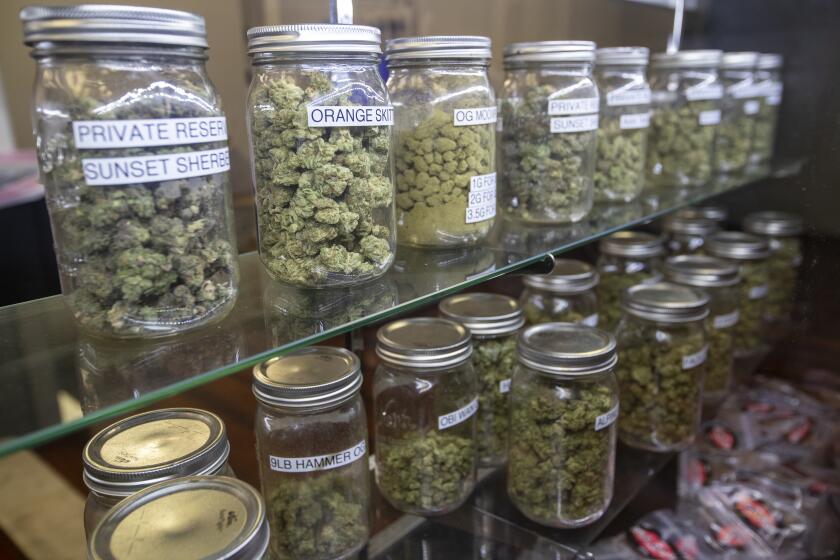The true pulse of L.A.? It emanates from this oddly shaped heart
Samuel Krueger likes Los Angeles. A lot. Which is noteworthy because he grew up in Portland, Ore., where the word “Californication” was coined to describe L.A.’s baleful influence.
Portland has a well-defined urban core, while Dorothy Parker’s description of L.A. — 72 suburbs in search of a city — has stuck with us, for good reason. Krueger, however, says L.A. and Portland have the same energy. And now he’s discovered from where it springs: L.A. has an urban center after all.
Krueger, 29, works in geographic information systems for the Los Angeles Department of Water and Power. He is tall, bearded and resembles both a Pacific Northwest mountain man and an academic. His find came in an award-winning masters’ thesis in geography studies at USC.
Krueger used an algorithm to map concentrations of overlapping urban features like high-end retail shopping, restaurants, nightclubs, theaters and museums. These clusters of “urban amenities,” he said, comprise Los Angeles’ urban center. Krueger named this core the “Santa Monica/Wilshire Corridor,” after the main arteries that run through it.
“City center” is perhaps a misnomer for Krueger’s core. His corridor crosses city boundaries. It’s really long and shaped somewhat like a crab. It runs along the base of the Santa Monica Mountains from the beach to downtown. Hollywood, West Hollywood, Westwood, Beverly Hills, Venice, Melrose Avenue, 3rd Street, Beverly Boulevard and Koreatown are all part of it.
It may not look like other city centers, Krueger acknowledged. But it functions like other city centers, the source of street life and urban vitality. It’s defined by the same features as the center of “real” cities, like the Loop in Chicago and Manhattan in New York City, he said in his thesis.
“I don’t want to say it’s comparable to Manhattan or the Loop in any aesthetic sense; obviously it’s not,” he said. “Los Angeles has its own way of making a center.”
Krueger’s map captures something real and true about Los Angeles. It encompasses the parts of the city where buzz begins and public life flourishes. It’s the L.A. that matters.
But I couldn’t quite get my head around the logic he used to come up with the boundaries. Krueger agreed to meet me at Umami Burger in Santa Monica so he could show me what he was talking about.
The joint was jumping. Across from us, a young mother, with the help of two nannies, struggled to keep her little noise-makers in check. Dudes drank beer and peered into their smartphones, reading text messages.
The thriving Umami burger chain could be a metaphor for Krueger’s corridor: it started in mid-Wilshire, spread to Los Feliz and downtown and landed in Santa Monica, inside the trendy retail emporium Fred Segal.
After dinner, we walked to 4th Street, where Krueger pointed out Magicopolis, a magic shop that also does live theater. Nearby was a juice bar, a cafe and full-service restaurants.
“There’s also a lot of hotels around here,” Krueger said. “The whole point of my thesis is you might have a cluster of coffee shops, but that is not an urban cluster. It’s when lots of different kinds of places are all
occurring in the same vicinity.”
On the Third Street Promenade, a break dance troupe was performing. The troupe leader, “Thrill,” pulled Krueger into the center of the circle of onlookers and tried to embarrass him into emptying his pockets. Thrill, an African American, addressed Krueger exclusively as “tall white man.”
“That was interesting,” Krueger said afterward, apparently undaunted. We passed a 71-year-old dancer in gauzy veils performing under the name “Scheherazade.”
“A lot of people who say Los Angeles has no street life must not be visiting the parts of town I’m visiting,” said Krueger, who lives in Hollywood.
The Santa Monica Pier was full of families, tweens and teens and strolling lovers. It draws people from all over the city, Krueger said.
“You may not have come here in 5 or 10 years,” Krueger said. “But everybody comes here sometimes.”
At the tip of the pier, we paused to watch the moonlight shimmer on the water.
“People say we don’t have a Central Park,” Krueger said. “But it’s staring them in the face: 100 miles of shoreline.”
One of the interesting things about Krueger’s analysis is how it breaks down the racial Balkanization through which L.A. is normally viewed. There’s no need to gentrify places like Koreatown and the Broadway shopping district downtown, he says; they’re already urban gems.
“Broadway doesn’t need revitalization,” he said. “The upper stories of the buildings could be more active, but the street life is already incredibly vibrant.”
Krueger’s theory has attracted some pushback. It rejects traditional definitions of city center based on employment or commercial activity. The Santa Monica/Wilshire Corridor is not uniform and its boundaries are fuzzy; there’s a hole in the middle for Hancock Park, a glitzy residential neighborhood with few “urban amenities.” Krueger, in his thesis, calls it a “postmodern urban center,” which is another way of saying not your father’s urban center, I guess.
But the biggest objections have come from people in places like Pasadena or Alhambra who don’t see L.A as a focal point at all. “A lot of people don’t see the structure,” Krueger told me. While we were finishing up at Umami, a young man at the next table leaned over and asked to see Krueger’s map.
“Where did you get this?” said Evan Waddell, 23, a native of Palos Verdes who works at a tech startup in Venice. “It’s so cool.” Krueger offered to email him a copy.
“To be honest, I never go east of Beverly Hills,” Waddell said.
Waddell’s orientation may skew South Bay and the Westside, but he knows Hollywood, West Hollywood, Melrose Avenue and clearly Santa Monica, where a chance encounter blossomed into a discussion among strangers. That’s what happens in urban centers.
“Great cities of the world define themselves,” Krueger said. “Los Angeles is generally acknowledged as one of the five, six most iconic
and dynamic cities in the world. Why shouldn’t we try to appreciate what it has to offer on its own terms?”
More to Read
Sign up for Essential California
The most important California stories and recommendations in your inbox every morning.
You may occasionally receive promotional content from the Los Angeles Times.
